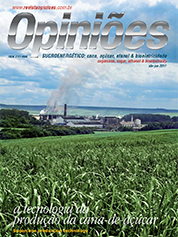Márcio Souza Leão Bastos
Special Sales Manager for Sugarcane at CNH Latin America
Op-AA-28
Sugarcane straw harvesting
The partnership between New Holland and CTC (Sugarcane Technology Center) looks for new ways to produce energy, from sugarcane biomass. The idea is to combine the manufacturer’s experience and equipment with CTC’s sugarcane know-how, so that the project may produce clean energy, while diminishing process costs in the mill.
The advantages of bioelectricity, as it is called, are numerous. Among them, the fact that it is renewable, that it is less risk-prone, has shorter execution periods and emits less, in addition to the fact that it allows decentralized generation – producing energy close to consumer centers, thereby avoiding losses resulting from transmission.
The biomass used in this process is dry sugarcane straw (only 10% humidity), that is left over after harvesting. There are about 150 kg of dry straw for each harvested ton, which totals approximately 15 tons of straw per hectare per year. Brazil is headed towards full mechanical harvesting, with no burning, so it is essential that one make use of biomass in the generation of energy.
According to data of UNICA (Sugarcane Industry Association), estimates are that in approximately ten years bioelectricity will generate the equivalent of three Belo Monte power plants. Several different processes can be used to collect straw in the field and take it to the mill. In the case of the New Holland – CTC partnership, the phase selected for study was baling, due to the equipment variety the company has to offer.
The selected method, in comparison with other methods, also allows achieving lower cost per Megawatt, resulting in more advantages to the agricultural producer. Thus, the harvesting of sugarcane is carried out normally. The straw is left on the ground in the sugarcane plantation area, when it is still wet. It needs to be left exposed to the weather for ten days, so that it can dry.
After the straw drying period, the biomass is lined up using an windrower. Next comes a baling machine that makes the actual bales, called “giants” – each is about 2.2 meters long and weighs 450 kg. Finally, the bale wagon forwards the material to the loading site, from where it goes on to the mill.
New Holland offers the market a baling machine that stands out for the easiness with which it removes material, thanks to its curved pickup tines, with short spaces between them, which, in combination with pickup wheels, help clean the field, even at high speeds. Its dual lashing system allows for higher bale density, less force applied to the lashing system and higher reliability of knots.
Apart from double knots, six cords hold bales together, even in the case of high density bales. It is important, however, to point out that only some of the straw is collected from the ground – from 25% to 50% of the total. This quantity varies according to weather and soil conditions, given that sugarcane biomass is very important for this crop. In drier places, for example, more straw on the ground is needed, to keep the soil humid.
Also in the case of soil with higher organic material content. In other cases, during winter, too much straw can stand in the way of sugarcane’s growth. Once the defined quantity is collected and baled in the mill, before the biomass is burned in the boilers, the straw is grinded. It is necessary that it be of about the same size as sugarcane bagasse, with which it will be blended for burning.
Thus, steam is generated which, through a generator, is transformed into energy. Some of the energy produced is consumed in the mill itself, while the surplus is sold. This energy is produced during the dry season, when the complementary harvest takes place and water levels in the hydroelectric power plant dams are low.
In this manner, it is possible to save energy produced in the most common of methods, in which Brazil ranks as the world’s second largest producer, according to UNICA data. Our quest is for the lowest cost possible to produce Megawatts/hour.
Thus, apart from producing clean and renewable energy, in a process of little complexity and easy to implement, it generates revenue for the mill, lowering sugar and ethanol production costs. The partnership of New Holland and CTC has been productive and has attracted the attention of groups concerned about this type of projects involving renewable energy from rarely used sources.




